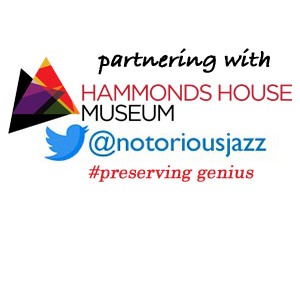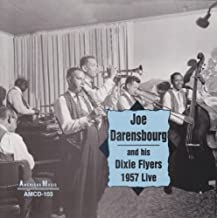
Daily Dose Of Jazz…
Joe Darensbourg was born in Baton Rouge, Louisiana on July 9, 1906 and in his youth moved out to California where he played gigs where he could find them and appeared in several silent films with these bands. In 1950 Joe appeared in Mahogany Magic with Kid Ory’s Creole Jazz Band. The Sixties saw him playing with Louis Armstrong’s All Stars in The Good Years of Jazz: Louis Armstrong & The All Stars.
In 1958 his Dixie Fliers recording of Yellow Dog Blues hit #43 on the pop charts, and Louis Armstrong’s version of Hello Dolly, which Drensburg played clarinet went to #1 in 1964. By the Sixties he performed on a television special with the All Stars Winter Carnival in Sun Valley, California and a March of Dimes tribute to Louis Armstrong.
He was noted for his work with Buddy Petit, Jelly Roll Morton, Charlie Creath, Fate Marable, Andy Kirk, Johnny Wittwer, Kid Ory, Wingy Manone, Joe Liggins and Louis Armstrong. Clarinetist and saxophonist Joe Darensbourg, who played Dixieland, passed away on May 24, 1985.More Posts: clarinet,history,instrumental,music,saxophone
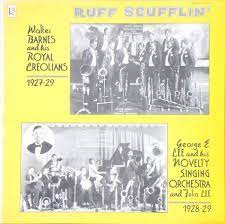
Daily Dose Of Jazz..
Walter Barnes was born on July 8, 1905 in Vicksburg, Mississippi but grew up in Chicago, Illinois. He studied under Franz Schoepp and attended the Chicago Musical College and the American Conservatory of Music.
Leading his own bands from the early 1920s, he also played with Detroit Shannon and his Royal Creolians. After Shannon’s retinue became dissatisfied with his leadership, Barnes took control of this group as well. He played mostly in Chicago, though the band did hold a residency at the Savoy Ballroom in New York City as well. His band recorded in 1928-29 for Brunswick Records.
He toured the American South in the 1930s to considerable success, touring there yearly and by 1938 the ensemble grew to sixteen members. Around this time, Barnes also worked as a columnist for the Chicago Defender newspaper, and used his position to advertise his own tours and promote other entertainers on the same touring trail to Black audiences. Barnes is thus credited as an early originator of what was known as the “Chitlin’ Circuit”; a network of entertainment venues where it was safe and acceptable for Black entertainers to perform.
Barnes was one of the victims of the Rhythm Club Fire in Natchez, Mississippi, on April 23, 1940. When the club caught fire, he had the group continue playing the song “Marie” in order to keep the crowd from stampeding out of the building. All of the band members except for drummer Walter Brown and bassist Arthur Edward were among the 201 victims of the fire.
Clarinetist, saxophonist and bandleader Walter Barnes, whose death was repeatedly immortalized in song, passed away on April 23, 1940.
More Posts: bandleader,clarinet,history,instrumental,jazz,music,saxophone
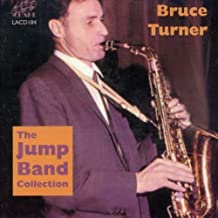
Daily Dose Of Jazz…
Bruce Turner was born on July 5, 1922 in Saltburn, North Yorkshire, England and educated at Dulwich College. He learned to play the clarinet as a schoolboy and began playing alto saxophone while serving in the Royal Air Force in 1943 during World War II. He played with Freddy Randall from 1948~53 and then worked on the Queen Mary in a dance band and in a quartet with Dill Jones and Peter Ind.
In 1950 he briefly studied under Lee Konitz in New York City. His first period with Humphrey Lyttelton ran from 1953 to 1957. After leaving Lyttelton he led his Jump Band from 1957~65, which was featured along with his arrangements in the 1961 film Living Jazz. In 1961, Turner recorded Jumpin’ at the NFT (National Film Theatre) and the album was issued later that year on Doug Dobell’s 77 Records label, coinciding with the film’s release.
In January 1963, the British music magazine New Musical Express reported that the biggest trad jazz event to be staged in Britain had taken place at Alexandra Palace. The event included George Melly, Diz Disley, Acker Bilk, Chris Barber, Kenny Ball, Ken Colyer, Monty Sunshine, Bob Wallis, Alex Welsh, Mick Mulligan and Turner.
Returning to Randall’s group from 1964 to 1966, he then played with Don Byas and Acker Bilk till 1970. He went on to work with Wally Fawkes, John Chilton, Stan Greig), Alex Welsh, and Dave Green. He led small ensembles in the 1990s until his death. His autobiography Hot Air, Cool Music, published by Quartet Books, appeared in 1984. He wrote a column on jazz for the Daily Worker. Saxophonist, clarinetist, and bandleader Bruce Turner passed away on November 28, 1993 in Newport Pagnell.
More Posts: clarinet,history,instrumental,jazz,music,saxophone
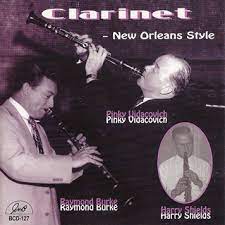
Daily Dose Of Jazz…
Harry Shields was born on June 30, 1899 at 2319 First Street in Uptown, New Orleans, Louisiana, two doors down from Buddy Bolden’s house. He spent almost his whole career in New Orleans. He played with the bands of Norman Brownlee, Sharkey Bonano, Tom Brown, Johnny Wiggs, and others.
Many of his fellow musicians regarded Harry as a superior clarinetist to his brother Larry, who became a noted musician. Wiggs had once commented that Harry was the only clarinetist he’d heard who could always play the right note without fail. He was a part of George Girard and His New Orleans Five, and Johnny Wiggs and His New Orleans Band.
Clarinetist Harry Shields passed away in his hometown on January 19, 1971.
More Posts: clarinet,history,instrumental,jazz,music

Daily Dose Of Jazz…
Albert King was born on June 19, 1912 in Panama and raised in Kingston, Jamaica where he attended Alpha Boys School. During the 1930s he led his own band, Bertie King and his Rhythm Aces, one of Jamaica’s foremost dance orchestras.
Leaving the island in 1936, he sailed to England on the same ship as his friend Jiver Hutchinson. Once in London he joined Ken Snakehips Johnson’s West Indian Dance Band, then played with Leslie Hutchinson’s band. He also worked with visiting American musicians including Benny Carter, George Shearing and Coleman Hawkins.
In 1937, while in the Netherlands he recorded four sides in the Netherlands with Benny Carter, and the next year he recorded with Django Reinhardt in Paris, France. In 1939 he joined the Royal Navy. He left the Navy in 1943 and formed his own band, also working and recording with Nat Gonella.
Returning to Jamaica in 1951, he assembled his own band, the Casa Blanca Orchestra, playing in the mento style. With no Jamaican record labels at this time, he arranged for his recordings to be pressed in a plant in Lewisham, England, owned by Decca Records. Bertie returned a number of times to the United Kingdom, working and recording with Kenny Baker, George Chisholm, Chris Barber, Kenny Graham and Humphrey Lyttelton. During this period in his career he toured Asia and Africa with his own band and played and recorded in London with some of the leading Trinidadian calypsonians.
King went on to lead the Jamaica Broadcasting Corporation house band in the 1950s. His sidemen included Ernest Ranglin and Tommy Mowatt. He recorded extensively with this outfit, until 1965 when he moved to the USA. His last known public performance was in New York City in 1967. Clarinetist and saxophonist Bertie King passed away in 1981.
More Posts: bandleader,clarinet,history,instrumental,jazz,music



